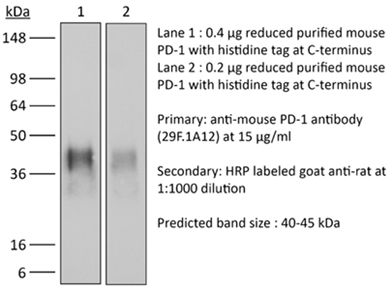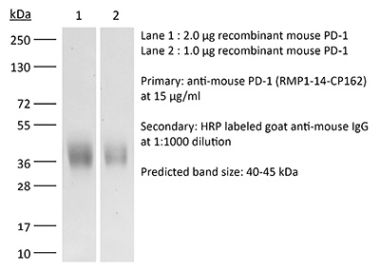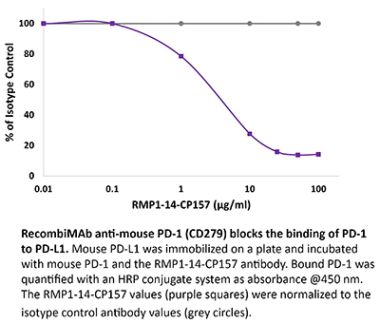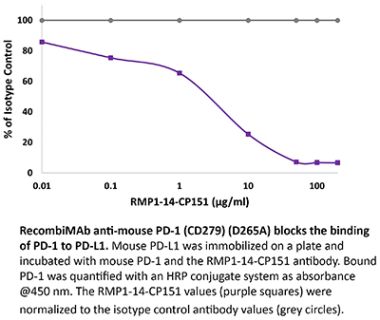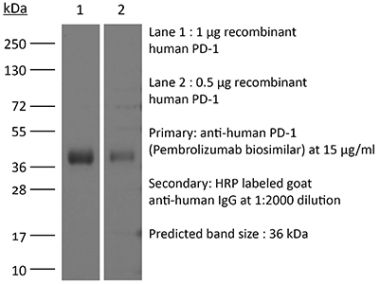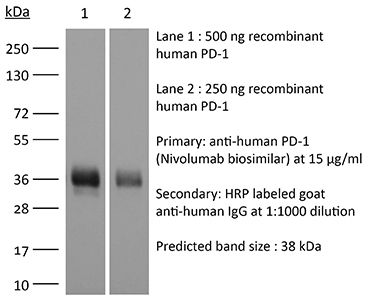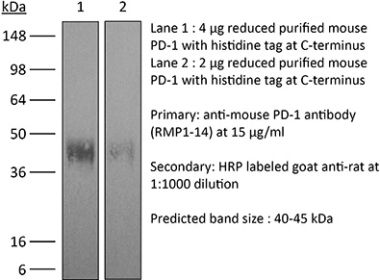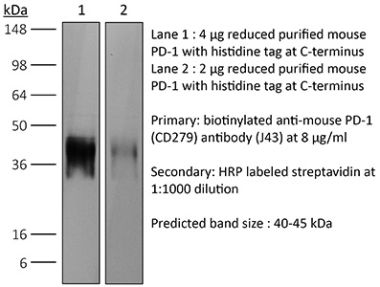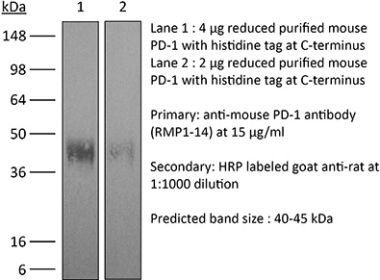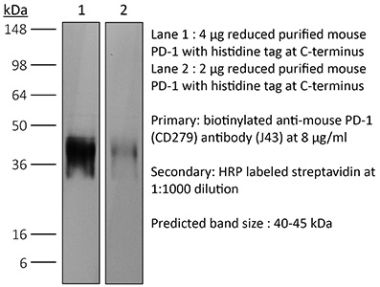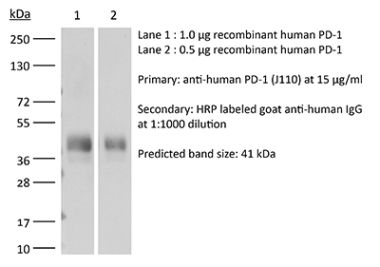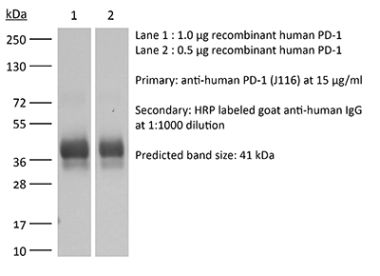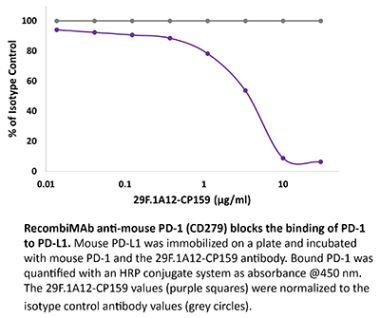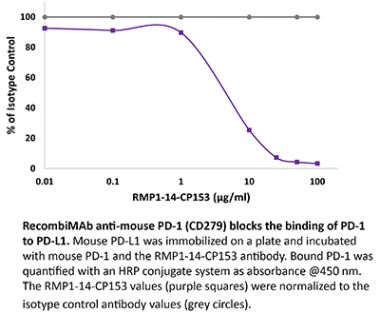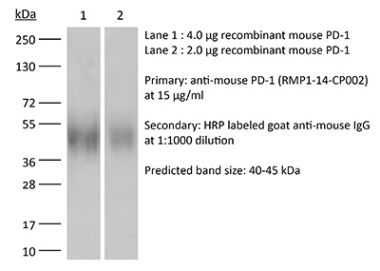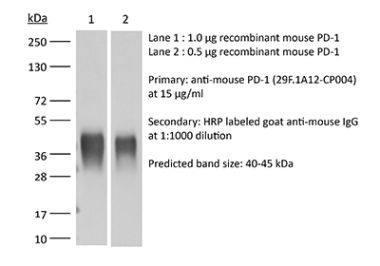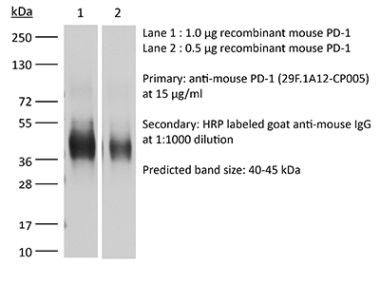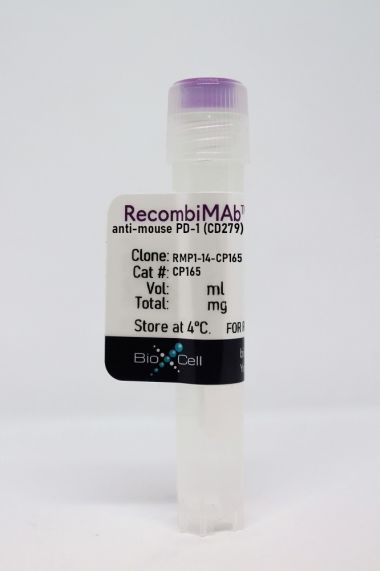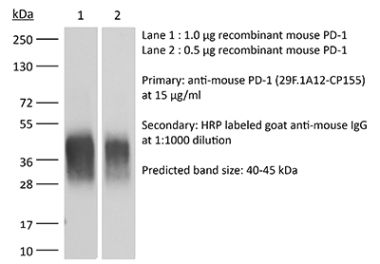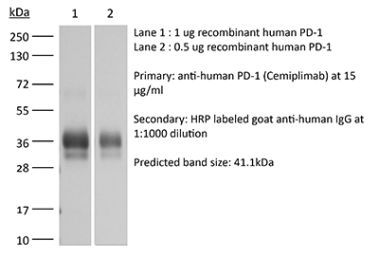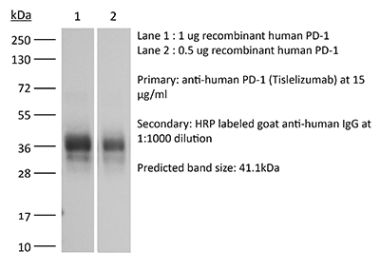InVivoMAb anti-mouse PD-1 (CD279)
Product Details
The 29F.1A12™ monoclonal antibody reacts with mouse PD-1 (programmed death-1) also known as CD279. PD-1 is a 50-55 kDa cell surface receptor encoded by the Pdcd1 gene that belongs to the CD28 family of the Ig superfamily. PD-1 is transiently expressed on CD4 and CD8 thymocytes as well as activated T and B lymphocytes and myeloid cells. PD-1 expression declines after successful elimination of antigen. Additionally, Pdcd1 mRNA is expressed in developing B lymphocytes during the pro-B-cell stage. PD-1’s structure includes a ITIM (immunoreceptor tyrosine-based inhibitory motif) suggesting that PD-1 negatively regulates TCR signals. PD-1 signals via binding its two ligands, PD-L1 and PD-L2 both members of the B7 family. Upon ligand binding, PD-1 signaling inhibits T-cell activation, leading to reduced proliferation, cytokine production, and T-cell death. Additionally, PD-1 is known to play key roles in peripheral tolerance and prevention of autoimmune disease in mice as PD-1 knockout animals show dilated cardiomyopathy, splenomegaly, and loss of peripheral tolerance. Induced PD-L1 expression is common in many tumors including squamous cell carcinoma, colon adenocarcinoma, and breast adenocarcinoma. PD-L1 overexpression results in increased resistance of tumor cells to CD8 T cell mediated lysis. In mouse models of melanoma, tumor growth can be transiently arrested via treatment with antibodies which block the interaction between PD-L1 and its receptor PD-1. For these reasons anti-PD-1 mediated immunotherapies are currently being explored as cancer treatments. Like the RMP1-14 and J43 antibodies the 29F.1A12™ antibody has been shown to block the binding of PD-1 to its ligands in vivo.Specifications
| Isotype | Rat IgG2a |
|---|---|
| Recommended Isotype Control(s) | InVivoMAb rat IgG2a isotype control, anti-trinitrophenol |
| Recommended Dilution Buffer | InVivoPure pH 7.0 Dilution Buffer |
| Conjugation | This product is unconjugated. Conjugation is available via our Antibody Conjugation Services. |
| Immunogen | Recombinant PD-1-Ig fusion protein |
| Reported Applications |
in vivo blocking of PD-1/PD-L signaling in vitro PD-1 neutralization Immunohistochemistry (frozen) Immunofluorescence Western blot Flow cytometry |
| Formulation |
PBS, pH 7.0 Contains no stabilizers or preservatives |
| Endotoxin |
<2EU/mg (<0.002EU/μg) Determined by LAL gel clotting assay |
| Purity |
>95% Determined by SDS-PAGE |
| Sterility | 0.2 µm filtration |
| Production | Purified from cell culture supernatant in an animal-free facility |
| Purification | Protein G |
| RRID | AB_2687796 |
| Molecular Weight | 150 kDa |
| Storage | The antibody solution should be stored at the stock concentration at 4°C. Do not freeze. |
in vivo blocking of PD-1/PD-L signaling
Wang, W., et al. (2018). "RIP1 Kinase Drives Macrophage-Mediated Adaptive Immune Tolerance in Pancreatic Cancer" Cancer Cell 34(5): 757-774 e757. PubMed
Pancreatic ductal adenocarcinoma (PDA) is characterized by immune tolerance and immunotherapeutic resistance. We discovered upregulation of receptor-interacting serine/threonine protein kinase 1 (RIP1) in tumor-associated macrophages (TAMs) in PDA. To study its role in oncogenic progression, we developed a selective small-molecule RIP1 inhibitor with high in vivo exposure. Targeting RIP1 reprogrammed TAMs toward an MHCII(hi)TNFalpha(+)IFNgamma(+) immunogenic phenotype in a STAT1-dependent manner. RIP1 inhibition in TAMs resulted in cytotoxic T cell activation and T helper cell differentiation toward a mixed Th1/Th17 phenotype, leading to tumor immunity in mice and in organotypic models of human PDA. Targeting RIP1 synergized with PD1-and inducible co-stimulator-based immunotherapies. Tumor-promoting effects of RIP1 were independent of its co-association with RIP3. Collectively, our work describes RIP1 as a checkpoint kinase governing tumor immunity.
in vivo blocking of PD-1/PD-L signaling
Gordon, S. R., et al. (2017). "PD-1 expression by tumour-associated macrophages inhibits phagocytosis and tumour immunity" Nature 545(7655): 495-499. PubMed
Programmed cell death protein 1 (PD-1) is an immune checkpoint receptor that is upregulated on activated T cells for the induction of immune tolerance. Tumour cells frequently overexpress the ligand for PD-1, programmed cell death ligand 1 (PD-L1), facilitating their escape from the immune system. Monoclonal antibodies that block the interaction between PD-1 and PD-L1, by binding to either the ligand or receptor, have shown notable clinical efficacy in patients with a variety of cancers, including melanoma, colorectal cancer, non-small-cell lung cancer and Hodgkin’s lymphoma. Although it is well established that PD-1-PD-L1 blockade activates T cells, little is known about the role that this pathway may have in tumour-associated macrophages (TAMs). Here we show that both mouse and human TAMs express PD-1. TAM PD-1 expression increases over time in mouse models of cancer and with increasing disease stage in primary human cancers. TAM PD-1 expression correlates negatively with phagocytic potency against tumour cells, and blockade of PD-1-PD-L1 in vivo increases macrophage phagocytosis, reduces tumour growth and lengthens the survival of mice in mouse models of cancer in a macrophage-dependent fashion. This suggests that PD-1-PD-L1 therapies may also function through a direct effect on macrophages, with substantial implications for the treatment of cancer with these agents.
in vivo blocking of PD-1/PD-L signaling, Flow Cytometry
Koyama, S., et al. (2016). "Adaptive resistance to therapeutic PD-1 blockade is associated with upregulation of alternative immune checkpoints" Nat Commun 7: 10501. PubMed
Despite compelling antitumour activity of antibodies targeting the programmed death 1 (PD-1): programmed death ligand 1 (PD-L1) immune checkpoint in lung cancer, resistance to these therapies has increasingly been observed. In this study, to elucidate mechanisms of adaptive resistance, we analyse the tumour immune microenvironment in the context of anti-PD-1 therapy in two fully immunocompetent mouse models of lung adenocarcinoma. In tumours progressing following response to anti-PD-1 therapy, we observe upregulation of alternative immune checkpoints, notably T-cell immunoglobulin mucin-3 (TIM-3), in PD-1 antibody bound T cells and demonstrate a survival advantage with addition of a TIM-3 blocking antibody following failure of PD-1 blockade. Two patients who developed adaptive resistance to anti-PD-1 treatment also show a similar TIM-3 upregulation in blocking antibody-bound T cells at treatment failure. These data suggest that upregulation of TIM-3 and other immune checkpoints may be targetable biomarkers associated with adaptive resistance to PD-1 blockade.
in vivo blocking of PD-1/PD-L signaling
Koyama, S., et al. (2016). "STK11/LKB1 Deficiency Promotes Neutrophil Recruitment and Proinflammatory Cytokine Production to Suppress T-cell Activity in the Lung Tumor Microenvironment" Cancer Res 76(5): 999-1008. PubMed
STK11/LKB1 is among the most commonly inactivated tumor suppressors in non-small cell lung cancer (NSCLC), especially in tumors harboring KRAS mutations. Many oncogenes promote immune escape, undermining the effectiveness of immunotherapies, but it is unclear whether the inactivation of tumor suppressor genes, such as STK11/LKB1, exerts similar effects. In this study, we investigated the consequences of STK11/LKB1 loss on the immune microenvironment in a mouse model of KRAS-driven NSCLC. Genetic ablation of STK11/LKB1 resulted in accumulation of neutrophils with T-cell-suppressive effects, along with a corresponding increase in the expression of T-cell exhaustion markers and tumor-promoting cytokines. The number of tumor-infiltrating lymphocytes was also reduced in LKB1-deficient mouse and human tumors. Furthermore, STK11/LKB1-inactivating mutations were associated with reduced expression of PD-1 ligand PD-L1 in mouse and patient tumors as well as in tumor-derived cell lines. Consistent with these results, PD-1-targeting antibodies were ineffective against Lkb1-deficient tumors. In contrast, treating Lkb1-deficient mice with an IL6-neutralizing antibody or a neutrophil-depleting antibody yielded therapeutic benefits associated with reduced neutrophil accumulation and proinflammatory cytokine expression. Our findings illustrate how tumor suppressor mutations can modulate the immune milieu of the tumor microenvironment, and they offer specific implications for addressing STK11/LKB1-mutated tumors with PD-1-targeting antibody therapies.
in vitro PD-1 neutralization
Park, S. J., et al. (2014). "Negative role of inducible PD-1 on survival of activated dendritic cells" J Leukoc Biol 95(4): 621-629. PubMed
PD-1 is a well-established negative regulator of T cell responses by inhibiting proliferation and cytokine production of T cells via interaction with its ligands, B7-H1 (PD-L1) and B7-DC (PD-L2), expressed on non-T cells. Recently, PD-1 was found to be expressed in innate cells, including activated DCs, and plays roles in suppressing production of inflammatory cytokines. In this study, we demonstrate that PD-1 KO DCs exhibited prolonged longevity compared with WT DCs in the dLNs after transfer of DCs into hind footpads. Interestingly, upon LPS stimulation, WT DCs increased the expression of PD-1 and started to undergo apoptosis. DCs, in spleen of LPS-injected PD-1 KO mice, were more resistant to LPS-mediated apoptosis in vivo than WT controls. Moreover, treatment of blocking anti-PD-1 mAb during DC maturation resulted in enhanced DC survival, suggesting that PD-1:PD-L interactions are involved in DC apoptosis. As a result, PD-1-deficient DCs augmented T cell responses in terms of antigen-specific IFN-gamma production and proliferation of CD4 and CD8 T cells to a greater degree than WT DCs. Moreover, PD-1 KO DCs exhibited increased MAPK1 and CD40-CD40L signaling, suggesting a possible mechanism for enhanced DC survival in the absence of PD-1 expression. Taken together, our findings further extend the function of PD-1, which plays an important role in apoptosis of activated DCs and provides important implications for PD-1-mediated immune regulation.
in vivo blocking of PD-1/PD-L signaling
Cooper, Z. A., et al. (2014). "Response to BRAF inhibition in melanoma is enhanced when combined with immune checkpoint blockade" Cancer Immunol Res 2(7): 643-654. PubMed
BRAF-targeted therapy results in objective responses in the majority of patients; however, the responses are short lived ( approximately 6 months). In contrast, treatment with immune checkpoint inhibitors results in a lower response rate, but the responses tend to be more durable. BRAF inhibition results in a more favorable tumor microenvironment in patients, with an increase in CD8(+) T-cell infiltrate and a decrease in immunosuppressive cytokines. There is also increased expression of the immunomodulatory molecule PDL1, which may contribute to the resistance. On the basis of these findings, we hypothesized that BRAF-targeted therapy may synergize with the PD1 pathway blockade to enhance antitumor immunity. To test this hypothesis, we developed a BRAF(V600E)/Pten(-/-) syngeneic tumor graft immunocompetent mouse model in which BRAF inhibition leads to a significant increase in the intratumoral CD8(+) T-cell density and cytokine production, similar to the effects of BRAF inhibition in patients. In this model, CD8(+) T cells were found to play a critical role in the therapeutic effect of BRAF inhibition. Administration of anti-PD1 or anti-PDL1 together with a BRAF inhibitor led to an enhanced response, significantly prolonging survival and slowing tumor growth, as well as significantly increasing the number and activity of tumor-infiltrating lymphocytes. These results demonstrate synergy between combined BRAF-targeted therapy and immune checkpoint blockade. Although clinical trials combining these two strategies are ongoing, important questions still remain unanswered. Further studies using this new melanoma mouse model may provide therapeutic insights, including optimal timing and sequence of therapy.
in vivo blocking of PD-1/PD-L signaling, in vitro PD-1 neutralization
Duraiswamy, J., et al. (2013). "Dual blockade of PD-1 and CTLA-4 combined with tumor vaccine effectively restores T-cell rejection function in tumors" Cancer Res 73(12): 3591-3603. PubMed
Tumor progression is facilitated by regulatory T cells (Treg) and restricted by effector T cells. In this study, we document parallel regulation of CD8(+) T cells and Foxp3(+) Tregs by programmed death-1 (PD-1, PDCD1). In addition, we identify an additional role of CTL antigen-4 (CTLA-4) inhibitory receptor in further promoting dysfunction of CD8(+) T effector cells in tumor models (CT26 colon carcinoma and ID8-VEGF ovarian carcinoma). Two thirds of CD8(+) tumor-infiltrating lymphocytes (TIL) expressed PD-1, whereas one third to half of CD8(+) TIL coexpressed PD-1 and CTLA-4. Double-positive (PD-1(+)CTLA-4(+)) CD8(+) TIL had characteristics of more severe dysfunction than single-positive (PD-1(+) or CTLA-4(+)) TIL, including an inability to proliferate and secrete effector cytokines. Blockade of both PD-1 and CTLA-4 resulted in reversal of CD8(+) TIL dysfunction and led to tumor rejection in two thirds of mice. Double blockade was associated with increased proliferation of antigen-specific effector CD8(+) and CD4(+) T cells, antigen-specific cytokine release, inhibition of suppressive functions of Tregs, and upregulation of key signaling molecules critical for T-cell function. When used in combination with GVAX vaccination (consisting of granulocyte macrophage colony-stimulating factor-expressing irradiated tumor cells), inhibitory pathway blockade induced rejection of CT26 tumors in 100% of mice and ID8-VEGF tumors in 75% of mice. Our study indicates that PD-1 signaling in tumors is required for both suppressing effector T cells and maintaining tumor Tregs, and that PD-1/PD-L1 pathway (CD274) blockade augments tumor inhibition by increasing effector T-cell activity, thereby attenuating Treg suppression.
Flow Cytometry
Good-Jacobson, K. L., et al. (2012). "CD80 expression on B cells regulates murine T follicular helper development, germinal center B cell survival, and plasma cell generation" J Immunol 188(9): 4217-4225. PubMed
Germinal center (GC) B cells and T follicular helper (T(FH)) cells interact in the production of high-affinity long-lived plasma cells (PCs) and memory B cells, although the mechanisms regulating the formation of these long-lived populations remain unclear. Because CD80 is one of the few markers shared by human and murine memory B cells, we investigated its role in the development of GCs, memory cells, and PCs. In CD80-deficient mice, fewer long-lived PCs were generated upon immunization compared with that in B6 controls. In concert, the absence of CD80 resulted in an increase in apoptotic GC B cells during the contraction phase of the GC. CD80(-/-) mice had fewer T(FH) cells compared with that of B6, and residual T(FH) cells failed to mature, with decreased ICOS and PD-1 expression and decreased synthesis of IL-21 mRNA. Mixed bone marrow chimeras demonstrated a B cell-intrinsic requirement for CD80 expression for normal T(FH) cell and PC development. Therefore, B cell expression of CD80 plays a critical role in regulating B-T interactions in both early and late GC responses. This, in turn, results in impaired ability to produce long-lived PCs. These data provide new insights into the development of GCs and Ab-forming cells and the functions of CD80 in humoral immunity.
Immunofluorescence, Western Blot
Chen, L., et al. (2009). "Role of the immune modulator programmed cell death-1 during development and apoptosis of mouse retinal ganglion cells" Invest Ophthalmol Vis Sci 50(10): 4941-4948. PubMed
PURPOSE: Mammalian programmed cell death (PD)-1 is a membrane-associated receptor regulating the balance between T-cell activation, tolerance, and immunopathology; however, its role in neurons has not yet been defined. The hypothesis that PD-1 signaling actively promotes retinal ganglion cell (RGC) death within the developing mouse retina was investigated. METHODS: Mature retinal cell types expressing PD-1 were identified by immunofluorescence staining of vertical retina sections; developmental expression was localized by immunostaining and quantified by Western blot analysis. PD-1 involvement in developmental RGC survival was assessed in vitro using retinal explants and in vivo using PD-1 knockout mice. PD-1 ligand gene expression was detected by RT-PCR. RESULTS: PD-1 is expressed in most adult RGCs and undergoes dynamic upregulation during the early postnatal window of retinal cell maturation and physiological programmed cell death (PCD). In vitro blockade of PD-1 signaling during this time selectively increases the survival of RGCs. Furthermore, PD-1-deficient mice show a selective increase in RGC number in the neonatal retina at the peak of developmental RGC death. Lastly, gene expression of the immune PD-1 ligand genes Pdcd1lg1 and Pdcd1lg2 was found throughout postnatal retina maturation. CONCLUSIONS: These findings collectively support a novel role for a PD-1-mediated signaling pathway in developmental PCD during postnatal RGC maturation.
Immunohistochemistry (frozen)
Menke, J., et al. (2007). "Programmed death 1 ligand (PD-L) 1 and PD-L2 limit autoimmune kidney disease: distinct roles" J Immunol 179(11): 7466-7477. PubMed
The programmed death 1/programmed death 1 ligand (PD-L) pathway is instrumental in peripheral tolerance. Blocking this pathway exacerbates experimental autoimmune diseases, but its role in autoimmune kidney disease has not been explored. Therefore, we tested the hypothesis that the programmed death 1 ligands (PD-L1 and PD-L2), provide a protective barrier during T cell- and macrophage (Mphi)-dependent autoimmune kidney disease. For this purpose, we compared nephrotoxic serum nephritis (NSN) in mice lacking PD-L1 (PD-L1(-/-)), PD-L2 (PD-L2(-/-)), or both (PD-L1/L2(-/-)) to wild-type (WT) C57BL/6 mice. Kidney pathology, loss of renal function, and intrarenal leukocyte infiltrates were increased in each PD-L(-/-) strain as compared with WT mice. Although the magnitude of renal pathology was similar in PD-L1(-/-) and PD-L2(-/-) mice, our findings suggest that kidney disease in each strain is regulated by distinct mechanisms. Specifically, we detected increased CD68(+) cells along with elevated circulating IgG and IgG deposits in glomeruli in PD-L2(-/-) mice, but not PD-L1(-/-) mice. In contrast, we detected a rise in activated CD8(+) T cells in PD-L1(-/-) mice, but not PD-L2(-/-) mice. Furthermore, since PD-L1 is expressed by parenchymal and hemopoietic cells in WT kidneys, we explored the differential impact of PD-L1 expression on these cell types by inducing NSN in bone marrow chimeric mice. Our results indicate that PD-L1 expression on hemopoietic cells, and not parenchymal cells, is primarily responsible for limiting leukocyte infiltration during NSN. Taken together, our findings indicate that PD-L1 and PD-L2 provide distinct negative regulatory checkpoints poised to suppress autoimmune renal disease.
in vivo blocking of PD-1/PD-L signaling
Barber, D. L., et al. (2006). "Restoring function in exhausted CD8 T cells during chronic viral infection" Nature 439(7077): 682-687. PubMed
Functional impairment of antigen-specific T cells is a defining characteristic of many chronic infections, but the underlying mechanisms of T-cell dysfunction are not well understood. To address this question, we analysed genes expressed in functionally impaired virus-specific CD8 T cells present in mice chronically infected with lymphocytic choriomeningitis virus (LCMV), and compared these with the gene profile of functional memory CD8 T cells. Here we report that PD-1 (programmed death 1; also known as Pdcd1) was selectively upregulated by the exhausted T cells, and that in vivo administration of antibodies that blocked the interaction of this inhibitory receptor with its ligand, PD-L1 (also known as B7-H1), enhanced T-cell responses. Notably, we found that even in persistently infected mice that were lacking CD4 T-cell help, blockade of the PD-1/PD-L1 inhibitory pathway had a beneficial effect on the ‘helpless’ CD8 T cells, restoring their ability to undergo proliferation, secrete cytokines, kill infected cells and decrease viral load. Blockade of the CTLA-4 (cytotoxic T-lymphocyte-associated protein 4) inhibitory pathway had no effect on either T-cell function or viral control. These studies identify a specific mechanism of T-cell exhaustion and define a potentially effective immunological strategy for the treatment of chronic viral infections.
Immunohistochemistry (frozen)
Liang, S. C., et al. (2003). "Regulation of PD-1, PD-L1, and PD-L2 expression during normal and autoimmune responses" Eur J Immunol 33(10): 2706-2716. PubMed
Newer members of the B7-CD28 superfamily include the receptor PD-1 and its two ligands, PD-L1 and PD-L2. Here, we characterize the expression of PD-1, PD-L1, and PD-L2 in tissues of naive miceand in target organs from two models of autoimmunity, the pancreas from non-obese diabetic (NOD) mice and brain from mice with experimental autoimmune encephalomyelitis (EAE). In naive mice, proteiexpression of PD-1, PD-L1, and PD-L2 was detected in the thymus, while PD-1 and PD-L1 were detected in the spleen. PD-L1, but not PD-L2, was also detected at low levels on cardiac endothelium, pancreatic islets, and syncyciotrophoblasts in the placenta. In pre-diabetic NOD mice, PD-1 and PD-L1 were expressed on infiltrating cells in the pancreatic islets. Furthermore, PD-L1 was markedly up-regulated on islet cells. In brains from mice with EAE, PD-1, PD-L1, and PD-L2 were expressed on infiltrating inflammatory cells, and PD-L1 was up-regulated on endothelium within EAE brain. The distinct expression patterns of PD-L1 and PD-L2 led us to compare their transcriptional regulation in STAT4(-/-), STAT6(-/-), or NF-kappaB p50(-/-)p65(+/-) dendritic cells (DC).PD-L2, but not PD-L1, expression was dramatically reduced in p50(-/-)p65(+/-) DC. Thus, PD-L1 and PD-L2 exhibit distinct expression patterns and are differentially regulated on the transcriptional level.
- Mus musculus (House mouse),
- Immunology and Microbiology,
- Cancer Research
Assessing Longitudinal Treatment Efficacies and Alterations in Molecular Markers Associated with Glutamatergic Signaling and Immune Checkpoint Inhibitors in a Spontaneous Melanoma Mouse Model.
In JID Innovations on 1 March 2024 by Eddy, K., Gupta, K., et al.
PubMed
Previous work done by our laboratory described the use of an immunocompetent spontaneous melanoma-prone mouse model, TGS (TG-3/SKH-1), to evaluate treatment outcomes using inhibitors of glutamatergic signaling and immune checkpoint for 18 weeks. We showed a significant therapeutic efficacy with a notable sex-biased response in male mice. In this follow-up 18-week study, the dose of the glutamatergic signaling inhibitor was increased (from 1.7 mg/kg to 25 mg/kg), which resulted in improved responses in female mice but not male mice. The greatest reduction in tumor progression was observed in male mice treated with single-agent troriluzole and anti-PD-1. Furthermore, a randomly selected group of mice was removed from treatment after 18 weeks and maintained for up to an additional 48 weeks demonstrating the utility of the TGS mouse model to perform a ≥1-year preclinical therapeutic study in a physiologically relevant tumor-host environment. Digital spatial imaging analyses were performed in tumors and tumor microenvironments across treatment modalities using antibody panels for immune cell types and immune cell activation. The results suggest that immune cell populations and cytotoxic activities of T cells play critical roles in treatment responses in these mice. Examination of a group of molecular protein markers based on the proposed mechanisms of action of inhibitors of glutamatergic signaling and immune checkpoint showed that alterations in expression levels of xCT, γ-H2AX, EAAT2, PD-L1, and PD-1 are likely associated with the loss of treatment responses. These results suggest the importance of tracking changes in molecular markers associated with the mechanism of action of therapeutics over the course of a longitudinal preclinical therapeutic study in spatial and temporal manners. © 2024 The Authors.
- Mus musculus (House mouse),
- Immunology and Microbiology
LRP11 promotes stem-like T cells via MAPK13-mediated TCF1 phosphorylation, enhancing anti-PD1 immunotherapy.
In Journal for Immunotherapy of Cancer on 25 January 2024 by Sun, L., Ma, Z., et al.
PubMed
Tumor-infiltrating T cells enter an exhausted or dysfunctional state, which limits antitumor immunity. Among exhausted T cells, a subset of cells with features of progenitor or stem-like cells has been identified as TCF1+ CD8+ T cells that respond to immunotherapy. In contrast to the finding that TCF1 controls epigenetic and transcriptional reprogramming in tumor-infiltrating stem-like T cells, little is known about the regulation of TCF1. Emerging data show that elevated body mass index is associated with outcomes of immunotherapy. However, the mechanism has not been clarified. We investigated the proliferation of splenic lymphocytes or CD8+ T cells induced by CD3/CD28 stimulation in vitro. We evaluated the effects of low-density lipoprotein (LDL) and LRP11 inhibitors, as well as MAPK13 inhibitors. Additionally, we used shRNA technology to validate the roles of LRP11 and MAPK13. In an in vivo setting, we employed male C57BL/6J injected with B16 cells or MC38 cells to build a tumor model to assess the effects of LDL and LRP11 inhibitors, LRP11 activators, MAPK13 inhibitors on tumor growth. Flow cytometry was used to measure cell proportions and activation status. Molecular interactions and TCF1 status were examined using Western blotting. Moreover, we employed RNA sequencing to investigate the effects of LDL stimulation and MAPK13 inhibition in CD8+ T cells. By using a tumor-bearing mouse model, we found that LDL-induced tumor-infiltrating TCF1+PD1+CD8+ T cells. Using a cell-based chimeric receptor screening system, we showed that LRP11 interacted with LDL and activated TCF1. LRP11 activation enhanced TCF1+PD1+CD8+ T-cell-mediated antitumor immunity, consistent with LRP11 blocking impaired T-cell function. Mechanistically, LRP11 activation induces MAPK13 activation. Then, MAPK13 phosphorylates TCF1, leading to increase of stem-like T cells. LRP11-MAPK13-TCF1 enhanced antitumor immunity and induced tumor-infiltrating stem-like T cells. © Author(s) (or their employer(s)) 2024. Re-use permitted under CC BY-NC. No commercial re-use. See rights and permissions. Published by BMJ.
- Mus musculus (House mouse),
- Cancer Research
FGFR inhibition augments anti-PD-1 efficacy in murine FGFR3-mutant bladder cancer by abrogating immunosuppression.
In The Journal of Clinical Investigation on 16 January 2024 by Okato, A., Utsumi, T., et al.
PubMed
The combination of targeted therapy with immune checkpoint inhibition (ICI) is an area of intense interest. We studied the interaction of fibroblast growth factor receptor (FGFR) inhibition with ICI in urothelial carcinoma (UC) of the bladder, in which FGFR3 is altered in 50% of cases. Using an FGFR3-driven, Trp53-mutant genetically engineered murine model (UPFL), we demonstrate that UPFL tumors recapitulate the histology and molecular subtype of their FGFR3-altered human counterparts. Additionally, UPFL1 allografts exhibit hyperprogression to ICI associated with an expansion of T regulatory cells (Tregs). Erdafitinib blocked Treg proliferation in vitro, while in vivo ICI-induced Treg expansion was fully abrogated by FGFR inhibition. Combined erdafitinib and ICI resulted in high therapeutic efficacy. In aggregate, our work establishes that, in mice, co-alteration of FGFR3 and Trp53 results in high-grade, non-muscle-invasive UC and presents a previously underappreciated role for FGFR inhibition in blocking ICI-induced Treg expansion.
- Mus musculus (House mouse),
- Immunology and Microbiology
Recently activated CD4 T cells in tuberculosis express OX40 as a target for host-directed immunotherapy.
In Nature Communications on 19 December 2023 by Gress, A. R., Ronayne, C. E., et al.
PubMed
After Mycobacterium tuberculosis (Mtb) infection, many effector T cells traffic to the lungs, but few become activated. Here we use an antigen receptor reporter mouse (Nur77-GFP) to identify recently activated CD4 T cells in the lungs. These Nur77-GFPHI cells contain expanded TCR clonotypes, have elevated expression of co-stimulatory genes such as Tnfrsf4/OX40, and are functionally more protective than Nur77-GFPLO cells. By contrast, Nur77-GFPLO cells express markers of terminal exhaustion and cytotoxicity, and the trafficking receptor S1pr5, associated with vascular localization. A short course of immunotherapy targeting OX40+ cells transiently expands CD4 T cell numbers and shifts their phenotype towards parenchymal protective cells. Moreover, OX40 agonist immunotherapy decreases the lung bacterial burden and extends host survival, offering an additive benefit to antibiotics. CD4 T cells from the cerebrospinal fluid of humans with HIV-associated tuberculous meningitis commonly express surface OX40 protein, while CD8 T cells do not. Our data thus propose OX40 as a marker of recently activated CD4 T cells at the infection site and a potential target for immunotherapy in tuberculosis. © 2023. The Author(s).
- Cancer Research,
- Immunology and Microbiology
CRISPR screening identifies the deubiquitylase ATXN3 as a PD-L1-positive regulator for tumor immune evasion.
In The Journal of Clinical Investigation on 1 December 2023 by Wang, S., Iyer, R., et al.
PubMed
Regulation of tumoral PD-L1 expression is critical to advancing our understanding of tumor immune evasion and the improvement of existing antitumor immunotherapies. Herein, we describe a CRISPR-based screening platform and identified ATXN3 as a positive regulator for PD-L1 transcription. TCGA database analysis revealed a positive correlation between ATXN3 and CD274 in more than 80% of human cancers. ATXN3-induced Pd-l1 transcription was promoted by tumor microenvironmental factors, including the inflammatory cytokine IFN-γ and hypoxia, through protection of their downstream transcription factors IRF1, STAT3, and HIF-2α. Moreover, ATXN3 functioned as a deubiquitinase of the AP-1 transcription factor JunB, indicating that ATNX3 promotes PD-L1 expression through multiple pathways. Targeted deletion of ATXN3 in cancer cells largely abolished IFN-γ- and hypoxia-induced PD-L1 expression and consequently enhanced antitumor immunity in mice, and these effects were partially reversed by PD-L1 reconstitution. Furthermore, tumoral ATXN3 suppression improved the preclinical efficacy of checkpoint blockade antitumor immunotherapy. Importantly, ATXN3 expression was increased in human lung adenocarcinoma and melanoma, and its levels were positively correlated with PD-L1 as well as its transcription factors IRF1 and HIF-2α. Collectively, our study identifies what we believe to be a previously unknown deubiquitinase, ATXN3, as a positive regulator for PD-L1 transcription and provides a rationale for targeting ATXN3 to sensitize checkpoint blockade antitumor immunotherapy.
- Mus musculus (House mouse),
- Cancer Research,
- Cell Biology,
- Immunology and Microbiology
PD-1 signaling negatively regulates the common cytokine receptor γ chain via MARCH5-mediated ubiquitination and degradation to suppress anti-tumor immunity.
In Cell Research on 1 December 2023 by Liu, R., Zeng, L. W., et al.
PubMed
Combination therapy with PD-1 blockade and IL-2 substantially improves anti-tumor efficacy comparing to monotherapy. The underlying mechanisms responsible for the synergistic effects of the combination therapy remain enigmatic. Here we show that PD-1 ligation results in BATF-dependent transcriptional induction of the membrane-associated E3 ubiquitin ligase MARCH5, which mediates K27-linked polyubiquitination and lysosomal degradation of the common cytokine receptor γ chain (γc). PD-1 ligation also activates SHP2, which dephosphorylates γcY357, leading to impairment of γc family cytokine-triggered signaling. Conversely, PD-1 blockade restores γc level and activity, thereby sensitizing CD8+ T cells to IL-2. We also identified Pitavastatin Calcium as an inhibitor of MARCH5, which combined with PD-1 blockade and IL-2 significantly improves the efficacy of anti-tumor immunotherapy in mice. Our findings uncover the mechanisms by which PD-1 signaling antagonizes γc family cytokine-triggered immune activation and demonstrate that the underlying mechanisms can be exploited for increased efficacy of combination immunotherapy of cancer. © 2023. The Author(s).
- Mus musculus (House mouse),
- Cancer Research
Inducing the Abscopal Effect in Liver Cancer Treatment: The Impact of Microwave Ablation Power Levels and PD-1 Antibody Therapy.
In Pharmaceuticals (Basel, Switzerland) on 30 November 2023 by Liao, C., Zhang, G., et al.
PubMed
Microwave ablation (MWA) is an effective treatment for liver cancer (LC), but its impact on distant tumors remains to be fully elucidated. This study investigated the abscopal effects triggered by MWA treatment of LC, at different power levels and with or without combined immune checkpoint inhibition (ICI). We established a mouse model with bilateral subcutaneous LC and applied MWA of varied power levels to ablate the right-sided tumor, with or without immunotherapy. Left-sided tumor growth was monitored to assess the abscopal effect. Immune cell infiltration and distant tumor neovascularization were quantified via immunohistochemistry, revealing insights into the tumor microenvironment and neovascularization status. Th1- and Th2-type cytokine concentrations in peripheral blood were measured using ELISA to evaluate systemic immunological changes. It was found that MWA alone, especially at lower power, promoted distant tumor growth. On the contrary, combining high-power MWA with anti-programmed death (PD)-1 therapy promoted CD8+ T-cell infiltration, reduced regulatory T-cell infiltration, upregulated a Th1-type cytokine (TNF-α) in peripheral blood, and inhibited distant tumor growth. In summary, combining high-power MWA with ICI significantly enhances systemic antitumor immune responses and activates the abscopal effect, offering a facile and robust strategy for improving treatment outcomes.
- Immunology and Microbiology
Mutation in CDC42 gene set as a response biomarker for immune checkpoint inhibitor therapy
Preprint on MedRxiv : the Preprint Server for Health Sciences on 11 November 2023 by Wang, K., Zhang, Y., et al.
PubMed
Background Immunotherapy has proven notably effective in treating tumors across diverse patient populations. However, some patients do not respond to immune checkpoint inhibitors (ICIs). Thus, there is a need for reliable biomarkers that can predict clinical responses to ICI treatment accurately. Methods Our focus is on CDC42, a protein that stimulates multiple signaling pathways, promoting tumor growth. We hypothesize that its defective function may indicate a patient’s response to ICI therapy. We consider CDC42, along with its downstream binding and effector proteins, as a gene set. This is because their mutation could result in defective CDC42 function. We investigated the mutations in the CDC42 gene set as a potential biomarker for clinical benefits from ICI treatment. We also examined whether the combined use of a CDC42 inhibitor and ICI could enhance the efficacy of ICI. Results The presence of mutations in the CDC42 gene set correlated with improved overall survival (OS: p = 2.9E-4) and progression-free survival (PFS: p = 2.92E-6). Furthermore, our analysis of immune response landscapes among different CDC42 gene set statuses supports its potential as a biomarker for ICI therapy. Animal experiments also revealed that combining the CDC42 inhibitor (ML141) with anti-PD-1 blockade can synergistically reduce tumor growth. Conclusions: Our study suggests that the CDC42 gene set could serve as a novel biomarker for the clinical response to ICI treatment. This finding also provides insight into the potential of combining ICI and CDC42 inhibitor use.
- Mus musculus (House mouse),
- Immunology and Microbiology
Targeting TREM1 augments antitumor T cell immunity by inhibiting myeloid-derived suppressor cells and restraining anti-PD-1 resistance.
In The Journal of Clinical Investigation on 1 November 2023 by Ajith, A., Mamouni, K., et al.
PubMed
The triggering receptor expressed on myeloid cell 1 (TREM1) plays a critical role in development of chronic inflammatory disorders and the inflamed tumor microenvironment (TME) associated with most solid tumors. We examined whether loss of TREM1 signaling can abrogate the immunosuppressive TME and enhance cancer immunity. To investigate the therapeutic potential of TREM1 in cancer, we used mice deficient in Trem1 and developed a novel small molecule TREM1 inhibitor, VJDT. We demonstrated that genetic or pharmacological TREM1 silencing significantly delayed tumor growth in murine melanoma (B16F10) and fibrosarcoma (MCA205) models. Single-cell RNA-Seq combined with functional assays during TREM1 deficiency revealed decreased immunosuppressive capacity of myeloid-derived suppressor cells (MDSCs) accompanied by expansion in cytotoxic CD8+ T cells and increased PD-1 expression. Furthermore, TREM1 inhibition enhanced the antitumorigenic effect of anti-PD-1 treatment, in part, by limiting MDSC frequency and abrogating T cell exhaustion. In patient-derived melanoma xenograft tumors, treatment with VJDT downregulated key oncogenic signaling pathways involved in cell proliferation, migration, and survival. Our work highlights the role of TREM1 in cancer progression, both intrinsically expressed in cancer cells and extrinsically in the TME. Thus, targeting TREM1 to modify an immunosuppressive TME and improve efficacy of immune checkpoint therapy represents what we believe to be a promising therapeutic approach to cancer.
- In Vivo,
- Mus musculus (House mouse),
- Cancer Research,
- Immunology and Microbiology
BCL2 Inhibition Reveals a Dendritic Cell-Specific Immune Checkpoint That Controls Tumor Immunosurveillance.
In Cancer Discovery on 1 November 2023 by Zhao, L., Liu, P., et al.
PubMed
We developed a phenotypic screening platform for the functional exploration of dendritic cells (DC). Here, we report a genome-wide CRISPR screen that revealed BCL2 as an endogenous inhibitor of DC function. Knockout of BCL2 enhanced DC antigen presentation and activation as well as the capacity of DCs to control tumors and to synergize with PD-1 blockade. The pharmacologic BCL2 inhibitors venetoclax and navitoclax phenocopied these effects and caused a cDC1-dependent regression of orthotopic lung cancers and fibrosarcomas. Thus, solid tumors failed to respond to BCL2 inhibition in mice constitutively devoid of cDC1, and this was reversed by the infusion of DCs. Moreover, cDC1 depletion reduced the therapeutic efficacy of BCL2 inhibitors alone or in combination with PD-1 blockade and treatment with venetoclax caused cDC1 activation, both in mice and in patients. In conclusion, genetic and pharmacologic BCL2 inhibition unveils a DC-specific immune checkpoint that restrains tumor immunosurveillance. BCL2 inhibition improves the capacity of DCs to stimulate anticancer immunity and restrain cancer growth in an immunocompetent context but not in mice lacking cDC1 or mature T cells. This study indicates that BCL2 blockade can be used to sensitize solid cancers to PD-1/PD-L1-targeting immunotherapy. This article is featured in Selected Articles from This Issue, p. 2293. ©2023 American Association for Cancer Research.
- Mus musculus (House mouse),
- Cancer Research
The MYBL2-CCL2 axis promotes tumor progression and resistance to anti-PD-1 therapy in ovarian cancer by inducing immunosuppressive macrophages.
In Cancer Cell International on 21 October 2023 by Pan, B., Wan, T., et al.
PubMed
An immunosuppressive tumor microenvironment in ovarian cancer facilitates tumor progression and resistance to immunotherapy. The function of MYB Proto-Oncogene Like 2 (MYBL2) in the tumor microenvironment remains largely unexplored. A syngeneic intraovarian mouse model, flow cytometry analysis, and immunohistochemistry were used to explore the biological function of MYBL2 in tumor progression and immune escape. Molecular and biochemical strategies-namely RNA-sequencing, western blotting, quantitative reverse transcription-polymerase chain reaction (qRT-PCR), enzyme-linked immunosorbent assay, multiplex immunofluorescence, chromatic immunoprecipitation assay (CHIP) and luciferase assay-were used to reveal the mechanisms of MYBL2 in the OVC microenvironment. We found tumor derived MYBL2 indicated poor prognosis and selectively correlated with tumor associated macrophages (TAMs) in ovarian cancer. Mechanically, C-C motif chemokine ligand 2 (CCL2) transcriptionally activated by MYBL2 induced TAMs recruitment and M2-like polarization in vitro. Using a syngeneic intraovarian mouse model, we identified MYBL2 promoted tumor malignancyand increased tumor-infiltrating immunosuppressive macrophages. Cyclin-dependent kinase 2 (CDK2) was a known upstream kinase to phosphorylate MYBL2 and promote its transcriptional function. The upstream inhibitor of CDK2, CVT-313, reprogrammed the tumor microenvironment and reduced anti-PD-1 resistance. The MYBL2/CCL2 axis contributing to TAMs recruitment and M2-like polarization is crucial to immune evasion and anti-PD-1 resistance in ovarian cancer, which is a potential target to enhance the efficacy of immunotherapy. © 2023. BioMed Central Ltd., part of Springer Nature.
- Mus musculus (House mouse),
- Cancer Research,
- Genetics,
- Immunology and Microbiology
Novel miRNA-based drug CD5-2 reduces liver tumor growth in diethylnitrosamine-treated mice by normalizing tumor vasculature and altering immune infiltrate.
In Frontiers in Immunology on 5 October 2023 by Liu, K., Chen, J., et al.
PubMed
Liver cancers exhibit abnormal (leaky) vasculature, hypoxia and an immunosuppressive microenvironment. Normalization of tumor vasculature is an emerging approach to treat many cancers. Blockmir CD5-2 is a novel oligonucleotide-based inhibitor of the miR-27a interaction with VE-Cadherin, the endothelial-specific cadherin. The combination of a vasoactive medication with inhibition of immune checkpoints such as programmed cell death protein 1 (PD1) has been shown to be effective in treating liver cancer in humans. We aimed to study the effect of CD5-2 combined with checkpoint inhibition (using an antibody against PD1) on liver tumor growth, vasculature and immune infiltrate in the diethylnitrosamine (DEN)-induced liver tumor mouse model. We first analyzed human miR-27a and VE-Cadherin expression data from The Cancer Genome Atlas for hepatocellular carcinoma. CD5-2 and/or anti-PD1 antibody were given to the DEN-treated mice from age 7-months until harvest at age 9-months. Tumor and non-tumor liver tissues were analyzed using histology, immunohistochemistry, immunofluorescence and scanning electron microscopy. Human data showed high miR-27a and low VE-Cadherin were both significantly associated with poorer prognosis. Mice treated with CD5-2 plus anti-PD1 antibody had significantly smaller liver tumors (50% reduction) compared to mice treated with either agent alone, controls, or untreated mice. There was no difference in tumor number. Histologically, tumors in CD5-2-treated mice had less leaky vessels with higher VE-Cadherin expression and less tumor hypoxia compared to non-CD5-2-treated mice. Only tumors in the combination CD5-2 plus anti-PD1 antibody group exhibited a more favorable immune infiltrate (significantly higher CD3+ and CD8+ T cells and lower Ly6G+ neutrophils) compared to tumors from other groups. CD5-2 normalized tumor vasculature and reduced hypoxia in DEN-induced liver tumors. CD5-2 plus anti-PD1 antibody reduced liver tumor size possibly by altering the immune infiltrate to a more immunosupportive one. Copyright © 2023 Liu, Chen, Zhao, Boland, Ting, Lockwood, McKenzie, Kench, Vadas, Gamble and McCaughan.
- Mus musculus (House mouse),
- Cancer Research,
- Immunology and Microbiology
MFSD2A potentiates gastric cancer response to anti-PD-1 immunotherapy by reprogramming the tumor microenvironment to activate T cell response.
In Cancer Communications (London, England) on 1 October 2023 by Zhang, B., Wang, C. M., et al.
PubMed
The efficacy of anti-programmed cell death protein 1 (PD-1) immunotherapy in various cancers, including gastric cancer (GC), needs to be potentiated by more effective targeting to enhance therapeutic efficacy or identifying accurate biomarkers to predict clinical responses. Here, we attempted to identify molecules predicting or/and promoting anti-PD-1 therapeutic response in advanced GC (AGC). The transcriptome of AGC tissues from patients with different clinical responses to anti-PD-1 immunotherapy and GC cells was analyzed by RNA sequencing. The protein and mRNA levels of the major facilitator superfamily domain containing 2A (MFSD2A) in GC cells were assessed via quantitative real-time polymerase chain reaction, Western blotting, and immunohistochemistry. Additionally, the regulation of anti-PD-1 response by MFSD2A was studied in tumor-bearing mice. Cytometry by Time-of-Flight, multiple immunohistochemistry, and flow cytometry assays were used to explore immunological responses. The effects of MFSD2A on lipid metabolism in mice cancer tissue and GC cells was detected by metabolomics. Higher expression of MFSD2A in tumor tissues of AGC patients was associated with better response to anti-PD-1 immunotherapy. Moreover, MFSD2A expression was lower in GC tissues compared to adjacent normal tissues, and its expression was inversely correlated with GC stage. The overexpression of MFSD2A in GC cells enhanced the efficacy of anti-PD-1 immunotherapy in vivo by reprogramming the tumor microenvironment (TME), characterized by increased CD8+ T cell activation and reduced its exhaustion. MFSD2A inhibited transforming growth factor β1 (TGFβ1) release from GC cells by suppressing cyclooxygenase 2 (COX2)-prostaglandin synthesis, which consequently reprogrammed TME to promote anti-tumor T cell activation. MFSD2A potentially serves as a predictive biomarker for anti-PD-1 immunotherapy response in AGC patients. MFSD2A may be a promising therapeutic target to potentiate the efficacy of anti-PD-1 immunotherapy by reprogramming the TME to promote T cells activation. © 2023 The Authors. Cancer Communications published by John Wiley & Sons Australia, Ltd. on behalf of Sun Yat-sen University Cancer Center.
- Cancer Research,
- Immunology and Microbiology
The CX3CL1-CX3CR1 chemokine axis can contribute to tumor immune evasion and blockade with a novel CX3CR1 monoclonal antibody enhances response to anti-PD-1 immunotherapy.
In Frontiers in Immunology on 29 September 2023 by Chaudhri, A., Bu, X., et al.
PubMed
CX3CL1 secreted in the tumor microenvironment serves as a chemoattractant playing a critical role in metastasis of CX3CR1 expressing cancer cells. CX3CR1 can be expressed in both cancer and immune-inhibitory myeloid cells to facilitate their migration. We generated a novel monoclonal antibody against mouse CX3CR1 that binds to CX3CR1 and blocks the CX3CL1-CX3CR1 interaction. We next explored the immune evasion strategies implemented by the CX3CL1-CX3CR1 axis and find that it initiates a resistance program in cancer cells that results in 1) facilitation of tumor cell migration, 2) secretion of soluble mediators to generate a pro-metastatic niche, 3) secretion of soluble mediators to attract myeloid populations, and 4) generation of tumor-inflammasome. The CX3CR1 monoclonal antibody reduces migration of tumor cells and decreases secretion of immune suppressive soluble mediators by tumor cells. In combination with anti-PD-1 immunotherapy, this CX3CR1 monoclonal antibody enhances survival in an immunocompetent mouse colon carcinoma model through a decrease in tumor-promoting myeloid populations. Thus, this axis is involved in the mechanisms of resistance to anti-PD-1 immunotherapy and the combination therapy can overcome a portion of the resistance mechanisms to anti-PD-1. Copyright © 2023 Chaudhri, Bu, Wang, Gomez, Torchia, Hua, Hung, Davies, Lizee, Andrian, Hwu and Freeman.
- Immunology and Microbiology
Regulation of human and mouse bystander T cell activation responses by PD-1.
In JCI Insight on 22 September 2023 by Le, C. T., Vick, L. V., et al.
PubMed
Bystander activation of memory T cells occurs via cytokine signaling alone in the absence of T cell receptor (TCR) signaling and provides a means of amplifying T cell effector responses in an antigen-nonspecific manner. While the role of Programmed Cell Death Protein 1 (PD-1) on antigen-specific T cell responses is extensively characterized, its role in bystander T cell responses is less clear. We examined the role of the PD-1 pathway during human and mouse non-antigen-specific memory T cell bystander activation and observed that PD-1+ T cells demonstrated less activation and proliferation than activated PD-1- populations in vitro. Higher activation and proliferative responses were also observed in the PD-1- memory population in both mice and patients with cancer receiving high-dose IL-2, mirroring the in vitro phenotypes. This inhibitory effect of PD-1 could be reversed by PD-1 blockade in vivo or observed using memory T cells from PD-1-/- mice. Interestingly, increased activation through abrogation of PD-1 signaling in bystander-activated T cells also resulted in increased apoptosis due to activation-induced cell death (AICD) and eventual T cell loss in vivo. These results demonstrate that the PD-1/PD-Ligand 1 (PD-L1) pathway inhibited bystander-activated memory T cell responses but also protected cells from AICD.
- Mus musculus (House mouse),
- Immunology and Microbiology
Sex-Biased T-cell Exhaustion Drives Differential Immune Responses in Glioblastoma.
In Cancer Discovery on 6 September 2023 by Lee, J., Nicosia, M., et al.
PubMed
Sex differences in glioblastoma (GBM) incidence and outcome are well recognized, and emerging evidence suggests that these extend to genetic/epigenetic and cellular differences, including immune responses. However, the mechanisms driving immunologic sex differences are not fully understood. Here, we demonstrate that T cells play a critical role in driving GBM sex differences. Male mice exhibited accelerated tumor growth, with decreased frequency and increased exhaustion of CD8+ T cells in the tumor. Furthermore, a higher frequency of progenitor exhausted T cells was found in males, with improved responsiveness to anti-PD-1 treatment. Moreover, increased T-cell exhaustion was observed in male GBM patients. Bone marrow chimera and adoptive transfer models indicated that T cell-mediated tumor control was predominantly regulated in a cell-intrinsic manner, partially mediated by the X chromosome inactivation escape gene Kdm6a. These findings demonstrate that sex-biased predetermined behavior of T cells is critical for inducing sex differences in GBM progression and immunotherapy response. Immunotherapies in patients with GBM have been unsuccessful due to a variety of factors, including the highly immunosuppressive tumor microenvironment in GBM. This study demonstrates that sex-biased T-cell behaviors are predominantly intrinsically regulated, further suggesting sex-specific approaches can be leveraged to potentially improve the therapeutic efficacy of immunotherapy in GBM. See related commentary by Alspach, p. 1966. This article is featured in Selected Articles from This Issue, p. 1949. ©2023 The Authors; Published by the American Association for Cancer Research.
- Mus musculus (House mouse),
- Cancer Research,
- Immunology and Microbiology
Membrane-localized neoantigens predict the efficacy of cancer immunotherapy.
In Cell Reports Medicine on 15 August 2023 by Goldberger, Z., Hauert, S., et al.
PubMed
Immune checkpoint immunotherapy (ICI) can re-activate immune reactions against neoantigens, leading to remarkable remission in cancer patients. Nevertheless, only a minority of patients are responsive to ICI, and approaches for prediction of responsiveness are needed to improve the success of cancer treatments. While the tumor mutational burden (TMB) correlates positively with responsiveness and survival of patients undergoing ICI, the influence of the subcellular localizations of the neoantigens remains unclear. Here, we demonstrate in both a mouse melanoma model and human clinical datasets of 1,722 ICI-treated patients that a high proportion of membrane-localized neoantigens, particularly at the plasma membrane, correlate with responsiveness to ICI therapy and improved overall survival across multiple cancer types. We further show that combining membrane localization and TMB analyses can enhance the predictability of cancer patient response to ICI. Our results may have important implications for establishing future clinical guidelines to direct the choice of treatment toward ICI. Copyright © 2023 The Author(s). Published by Elsevier Inc. All rights reserved.
- Immunology and Microbiology
CD39 inhibition and VISTA blockade may overcome radiotherapy resistance by targeting exhausted CD8+ T cells and immunosuppressive myeloid cells.
In Cell Reports Medicine on 15 August 2023 by Zhang, Y., Hu, J., et al.
PubMed
Although radiotherapy (RT) has achieved great success in the treatment of non-small cell lung cancer (NSCLC), local relapses still occur and abscopal effects are rarely seen even when it is combined with immune checkpoint blockers (ICBs). Here, we characterize the dynamic changes of tumor-infiltrating immune cells after RT in a therapy-resistant murine tumor model using single-cell transcriptomes and T cell receptor sequencing. At the early stage, the innate and adaptive immune systems are activated. At the late stage, however, the tumor immune microenvironment (TIME) shifts into immunosuppressive properties. Our study reveals that inhibition of CD39 combined with RT preferentially decreases the percentage of exhausted CD8+ T cells. Moreover, we find that the combination of V-domain immunoglobulin suppressor of T cell activation (VISTA) blockade and RT synergistically reduces immunosuppressive myeloid cells. Clinically, high VISTA expression is associated with poor prognosis in patients with NSCLC. Altogether, our data provide deep insight into acquired resistance to RT from an immune perspective and present rational combination strategies. Copyright © 2023 The Authors. Published by Elsevier Inc. All rights reserved.
- In Vivo,
- Mus musculus (House mouse),
- Immunology and Microbiology,
- Cancer Research
Selective targeting of IL2Rβγ combined with radiotherapy triggers CD8- and NK-mediated immunity, abrogating metastasis in HNSCC.
In Cell Reports Medicine on 15 August 2023 by Gadwa, J., Amann, M., et al.
PubMed
The implementation of cancer immunotherapies has seen limited clinical success in head and neck squamous cell carcinoma (HNSCC). Interleukin-2 (IL-2), which modulates the survival and functionality of lymphocytes, is an attractive target for new immunotherapies but one that is limited by presence of regulatory T cells (Tregs) expressing the high-affinity IL-2Rα. The bispecific immunocytokine PD1-IL2v preferentially delivers IL-2 signaling through IL-2Rβγ on PD-1-expressing cells. Selectively targeting the intermediate-affinity IL-2Rβγ can be leveraged to induce anti-tumor immune responses in effector T cells and natural killer (NK) cells while limiting the negative regulation of IL-2Rα activation on Tregs. Using radiation therapy (RT) in combination with PD1-IL2v improves local tumor control and survival, and controls metastatic spread in orthotopic HNSCC tumor models. PD1-IL2v drives systemic activation and expansion of circulating and tumor-infiltrating cytotoxic T cells and NK cells while limiting Treg-mediated immunosuppression. These data show that PD1-L2v induces durable systemic tumor control in HNSCC. Copyright © 2023 The Authors. Published by Elsevier Inc. All rights reserved.
- Cancer Research
ANO1-Mediated Inhibition of Cancer Ferroptosis Confers Immunotherapeutic Resistance through Recruiting Cancer-Associated Fibroblasts.
In Advanced Science (Weinheim, Baden-Wurttemberg, Germany) on 1 August 2023 by Jiang, F., Jia, K., et al.
PubMed
The application of immunotherapy in gastrointestinal (GI) cancers remains challenging because of the limited response rate and emerging therapeutic resistance. Combining clinical cohorts, multi-omics study, and functional/molecular experiments, it is found that ANO1 amplification or high-expression predicts poor outcomes and resistance to immunotherapy for GI cancer patients. Knocking-down or inhibiting ANO1 suppresses the growth/metastasis/invasion of multiple GI cancer cell lines, cell-derived xenograft, and patient-derived xenograft models. ANO1 contributes to an immune-suppressive tumor microenvironment and induces acquired resistance to anti-PD-1 immunotherapy, while ANO1 knockdown or inhibition enhances immunotherapeutic effectiveness and overcomes resistance to immunotherapy. Mechanistically, through inhibiting cancer ferroptosis in a PI3K-Akt signaling-dependent manner, ANO1 enhances tumor progression and facilitates cancer-associated fibroblast recruitment by promoting TGF-β release, thus crippling CD8+ T cell-mediated anti-tumor immunity and generating resistance to immunotherapy. This work highlights ANO1's role in mediating tumor immune microenvironment remodeling and immunotherapeutic resistance, and introduces ANO1 as a promising target for GI cancers' precision treatment. © 2023 The Authors. Advanced Science published by Wiley-VCH GmbH.

